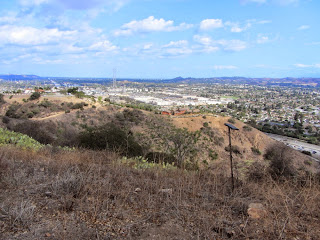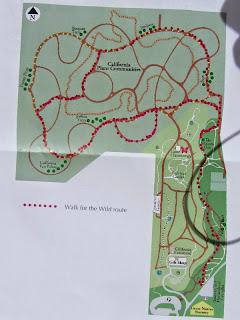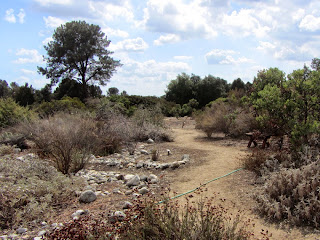I had spent Saturday at the celebrating-50-years-of-wilderness event in Claremont, so Sunday was going to be day to relax. But a backed-up sewer line has a way of arresting one’s total attention. After returning the rooter machine to The Home Depot rentals in Glendora, I decided to explore from a South Hills trailhead. Turning south on Elwood Avenue from Route 66, I found the trailhead for Alosta Canyon Trail at the entrance of Hidden Ranch Estates. The City of Glendora has done a nice job with trail signs and the Rotary Club has placed a little blue box on the sign post with maps. I took a map and figured I now had this trailhead scoped out for a future hike. But then I decided to walk up the trail for a minute or two just to get a feel for it. Yeah right, like I could stop myself.
2:50 – Begin hike with no intent to actually hike. I stroll south on the wide dirt road and within a minute arrive at a locked vehicle gate. I check the map and see that this Alosta Canyon Trail proceeds 0.6 mile to a ridge junction. That’s doable so I continue. Majestic live oaks and sycamores grace the route. Dead grass and wilting vegetation beg for rain. Pleasant temps and gentle breeze are fitting for the first weekend of autumn. Soon I pass a junction for East View North Fork Trail on the right, and shortly after, Alosta Canyon South Fork Trail on the left. The road bends west as it gently ascends the canyon. Poison oak begins to sport its fall colors. Nothing is in bloom. I’m really enjoying myself. The road bends south for its final pitch to the ridge.
3:02 - Ridge and South Hills Trail junction. This is a good vantage point and is at the heart of the range. Across the road views open up toward the vast suburban sprawl to the south. The freeway noise is now ever present. Scattered clouds provide interesting lighting. This was to be my turn around point. But how can I stop now?! There is a 1212-foot summit 0.5 mile to the east that is calling to me. But first I shall to turn right and check out North Spur Trail 50 yards to the west. Its high point offers some nice views east and north. I had pondered descending this route as a loop to reconnect with Alosta Canyon, but the summit draws me higher. After a few minutes here I return to the junction and continue east.
South Hills Trail is a wide dirt road running along the backbone of these hills (labeled South Hills Motorway on Google maps). Shortly I pass the junction for Bonny Cove East Trail on the right and in another minute reach a power tower. I now have a view east to my summit destination. I’m loving the beautiful weather, scattered clouds, and pleasant breeze. I’m really surprised that I’ve encountered no one else on the trails. I would have suspected that a trail system like this would have scads of users on a lovely weekend. I’m enjoying the varied vistas as I saunter along the undulating route. An expansive sea of prickly pear cactus on the south slope looks thirsty. Soon I reach a fork near Summit 1212. The map shows only the route branching left but I veer right and in a couple minutes reach another power tower. The route turns into a narrow path as it bends around the south face of the summit and then snakes through a patch of cactus heading to the top.
3:37 - Summit 1212. This is nice. It’s kind of like Azusa Peak but surrounded by city. The summit is wide and clear with pretty decent views as I move around. Some oaks block the northern panorama. There are four L.A. County survey control benchmarks. A two-foot pile of small rocks (known as a “cairn”) accents the summit. I add three rocks to it. A wide path leaving the summit east circles north and intersects South Hills Trail just below the summit (not shown on the map). The patchy clouds cast a patchwork of shadows over the surrounding human sprawl and nearby mountains. This would be a great place in the winter or early spring when everything is green and snow blankets the majestic San Gabriels. I’ve looked at these hills for years from the freeway and surface streets, but it’s such a different perspective to be on top on them.
3:53 - Leave the summit heading west. I saw a path leave the road earlier so I decide to see if it is a good route. It’s not. I crawl down the steep bank to the road and head north. I turn right at the junction and in about 50 yards reach the signed junction for Alosta Canyon South Fork Trail. This will be my return route. But first, I notice a fork which cuts right (southeast) around the summit and obviously the connector for the route I saw leaving the summit east. So climb up it for a one-minute walk back to the summit. This is clearly the most efficient route to the top. I exit the summit this time straight north through oak to climb down a narrow route back to the road. It works well. I’ve now tried all four paths to the peak.
4:08 - Start my decent on Alosta Canyon South Fork Trail. This narrow path zigzags northwest down the sheer canyon slope. It’s pretty steep with loose footing in places, but free from brush and quite doable. It would be a real huff and puff to climb. I carefully pick my way down the narrow trail. The map depicts only two of the dozen switchbacks the 0.4-mile trail negotiates. As I reach the canyon bottom, the trail passes beneath a canopy of oaks and returns me to Alosta Canyon Trail to complete the loop. Now back on the wide dirt road, I saunter the final 0.3 mile to the trailhead.
4:35 - Finish hike.
Epilog - What an enjoyable hour and 45 minutes! I’ve finally hiked South Hills. Sometimes spontaneity can offer a real treat. It’s amazing to me that I encountered no one! How can it be that that such a nice trial amidst a huge population center on a gorgeous autumn weekend has no users? Back before Garcia Trail closed in January 2014, there would be hundreds of trail users on a typical weekend day. Why aren’t some of them over here? But I’m thankful for the solitude, particularly since I’m dressed only in a ragged pair of jeans and a scrappy old t-shirt. I had no idea that when I dressed to clean out my sewer line this morning, I’d be hiking in these clothes. And by the way, even though I did not have the 10 essentials with me nor did I tell anyone where I was going, I did have a map, a compass (on my iPhone), and a phone…three of the most essential essentials.
Trail Guide
Season: November - May
This hike is best done in the winter or early spring when the hills are green, the temperatures are pleasant, and the air is clear. The winter offers delightful views of the glistening snow-capped high country. The spring offers an array of wildflowers. Early in the summer the “June gloom” (marine layer, coastal fog) can make nice walking conditions but also can greatly obscure your views. There is little shade en route, so this hike could be dreadful on a hot summer day: smog, haze, heat, blistering sun, brown hillsides. If you go in the summer, try daybreak or early evening. See Seasons of the San Gabriels for a detailed description of minding the seasons.
- Mystic Canyon Trail & Lower Monroe Road to Summit 2760 and Summit 3397
- Colby Trail to Glendora Mountain Road and Beyond























































